The Silk Factories of Italy: Upholding a Legacy of Opulence and Artisanship
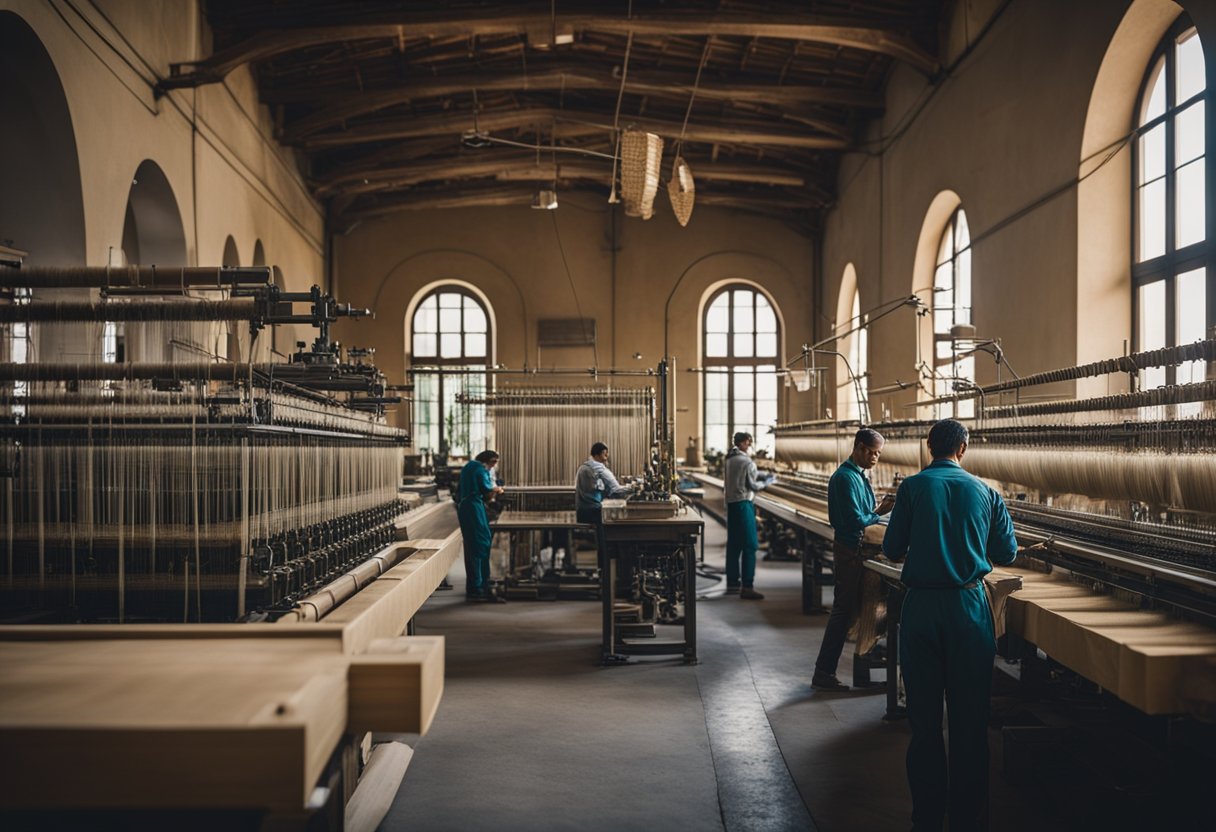
Updated On: April 17, 2024 by Aya Radwan
The silk factories of Italy are a testament to a heritage rich with elegance and artisanship. These workshops have been spinning luxury threads for centuries, intertwining tradition with the exquisite touch of Italian craftsmanship. In locales like the Lombardy region and the legendary city of Como, silk factories have long been at the heart of Italy’s reputation for sartorial excellence.
Our excursion into this opulent world uncovers a story woven with dedication and skill. Italian silk is sought after for its quality and beauty, and it is notable in fashion houses around the globe. From the cultivation of silkworms to the final touches in dyeing and weaving, each step is a respectful nod to the time-honoured methods that define this craft. This age-old journey from cocoon to loom highlights Italy’s unwavering commitment to preserving a legacy of luxury.
The Rich History of Italian Silk
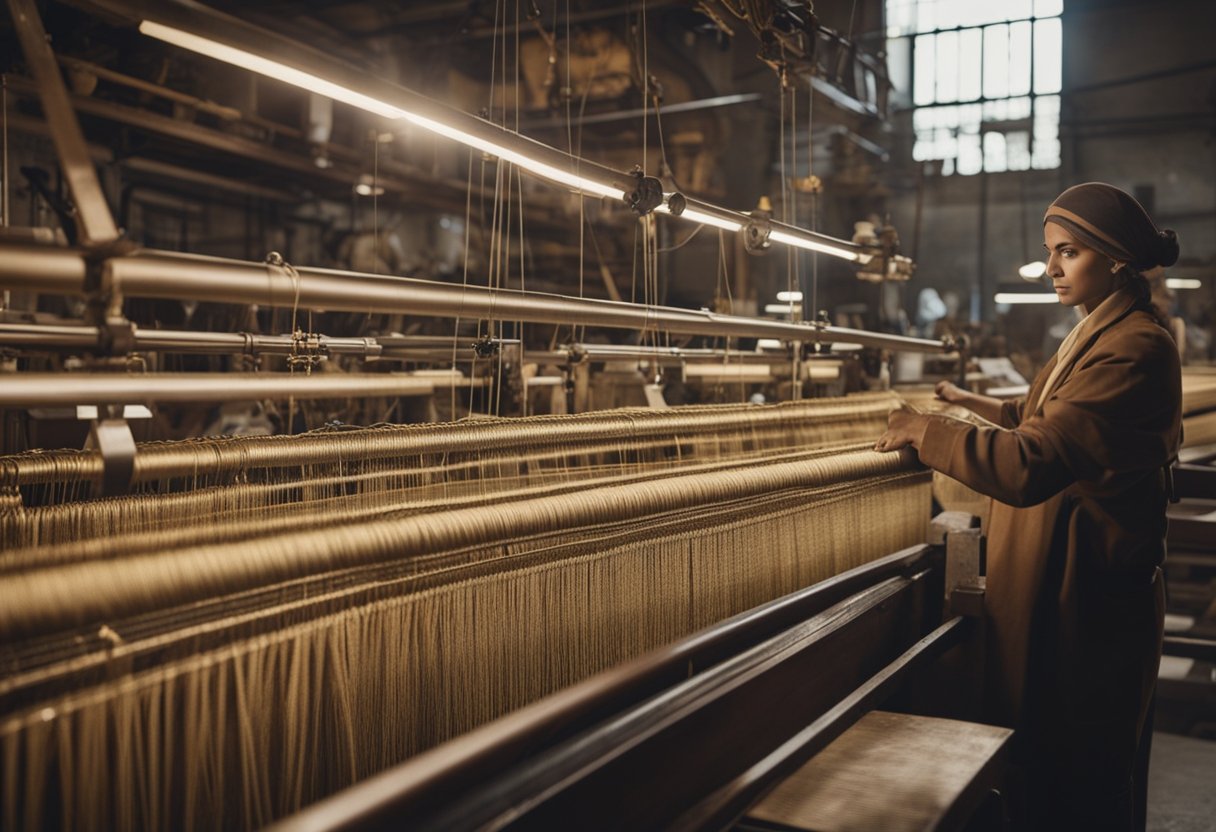
Italy’s legacy as a purveyor of silk is rooted in history and is as intricate and refined as the fabric itself. We’ll journey through the Renaissance splendour and the remarkable contributions of Leonardo da Vinci, unwrapping the threads of time to appreciate the evolution.
The Renaissance Period
Italy was a hive of innovation and artistic excellence during the Renaissance, a prosperous period for the silk industry. Cities like Florence and Venice became pivotal as silk-weaving centres, attracting artisans who would weave splendour into every thread. This era saw the creation of unrivalled silk textiles featuring intricate patterns and a quality that adorned nobility and clergy alike.
Leonardo da Vinci’s Influence
Leonardo da Vinci, a man of many talents, also left his mark on the silk industry with his inventive spirit. The great polymath conceptualised advanced weaving looms, enhancing the efficiency and complexity of silk production. His mechanical loom design, for instance, created more intricate fabric patterns, solidifying Italy’s place at the forefront of textile innovation.
Our foray into the rich history of Italian silk unfurls a testament to the nation’s dedication to craftsmanship and luxury. Through meticulous artistry and the genius of visionaries like da Vinci, Italy’s silk has woven its way into the fabric of history, cementing a legacy of elegance that endures today.
Cultivation and Silk Production Processes
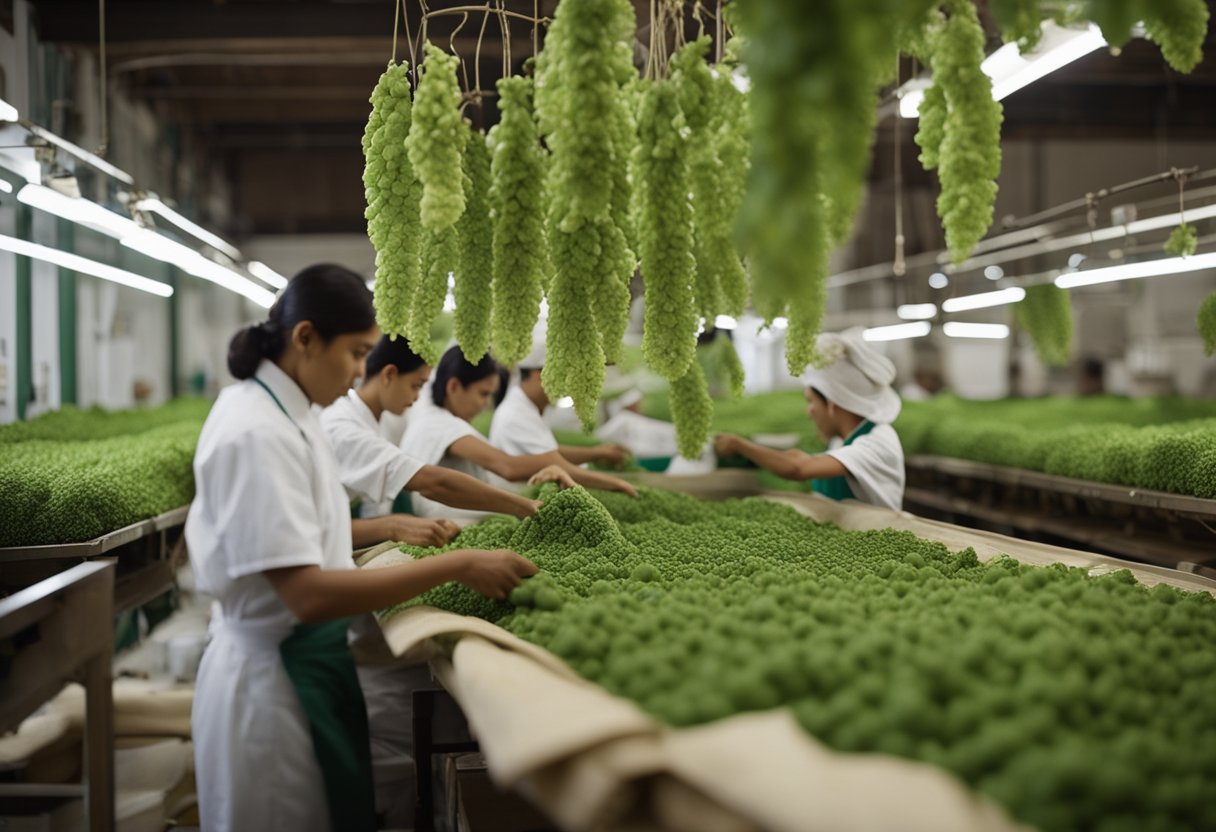
In this section, we examine the intricate stages Italy’s silk industry undergoes, from nurturing mulberry trees and silkworms to spinning yarn and subsequent textile manufacturing.
Mulberry Trees and Silkworms
Italy’s journey into silk production begins with the cultivation of mulberry trees, the primary diet of silkworm larvae. These trees are carefully tended to ensure the highest quality of leaves, crucial for nurturing healthy silkworms capable of producing fine silk threads. Once hatched, the silkworms are fastidiously fed with mulberry leaves at precise intervals to support their growth.
From Cocoon to Yarn
After the silkworms have spun their cocoons, a careful process begins to unreel the silk fibres. The cocoons are softened in hot water to facilitate the unwinding of the delicate fibres, which are then meticulously cleaned and spun into yarn. This yarn forms the raw material for various textiles and is revered for its strength, lustre, and texture unique to Italian silk craftsmanship.
Textile Manufacturing Techniques
Italian artisans employ diverse traditional textile manufacturing techniques to transform yarn into luxurious fabrics. Each method, from weaving to dying, is performed precisely to maintain the silk’s inherent qualities. Alongside modern advancements, these age-old techniques continue to define the prestige of Italian silk in the fashion and luxury goods markets worldwide.
The Silk Factories of Italy: Centres of Silk Excellence
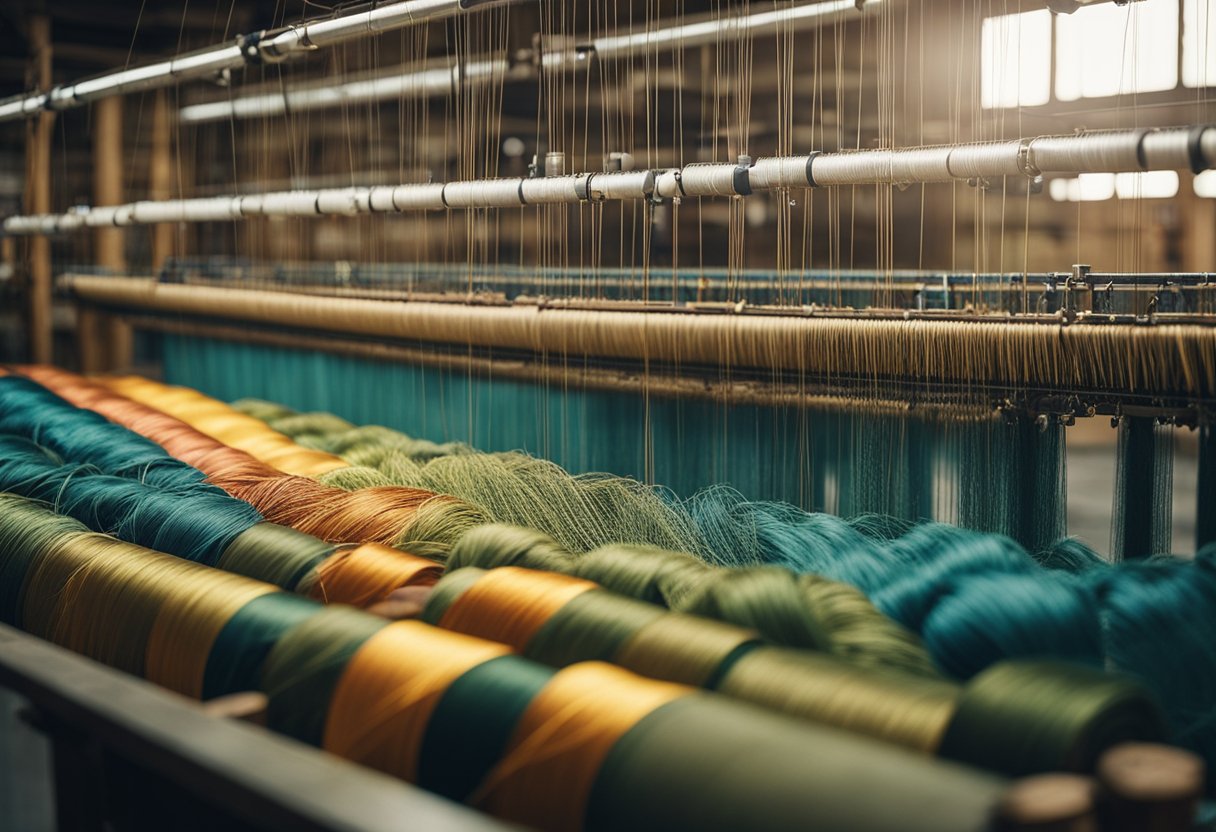
Italy’s reputation for luxury and quality in silk production is unparalleled, and a few centres stand out for their remarkable contributions to the silk trade. These locations are not simply places of manufacturing; they are where centuries-old traditions meet modern luxury.
Como: The Capital of Silk
Como has earned its title as the Capital of Silk due to its extensive silk production, a tradition that dates back to the 15th century. The area is renowned for its high-quality silk and innovative designs. We find that visitors to Como can explore the Lake Como Silk Museum, which meticulously preserves the history and machinery of this illustrious industry.
Florence and the Antico Setificio Fiorentino
In Florence, the Antico Setificio Fiorentino is a beacon of silk craftsmanship. This historic silk factory, using looms that date back to the Renaissance and a warping machine designed by Leonardo da Vinci, creates luxurious fabrics that have adorned the homes and fashions of the elite for centuries.
Venice and its Unique Textile History
The luxury of Venice’s silk is intertwined with its rich trading history, which brought in diverse influences that shaped its textile designs. Though often overlooked in favour of its famous glass and carnival masks, Venice’s textile history is one of intricate brocades and velvets of unparalleled detail and craftsmanship.
Famous Italian Silk Factories
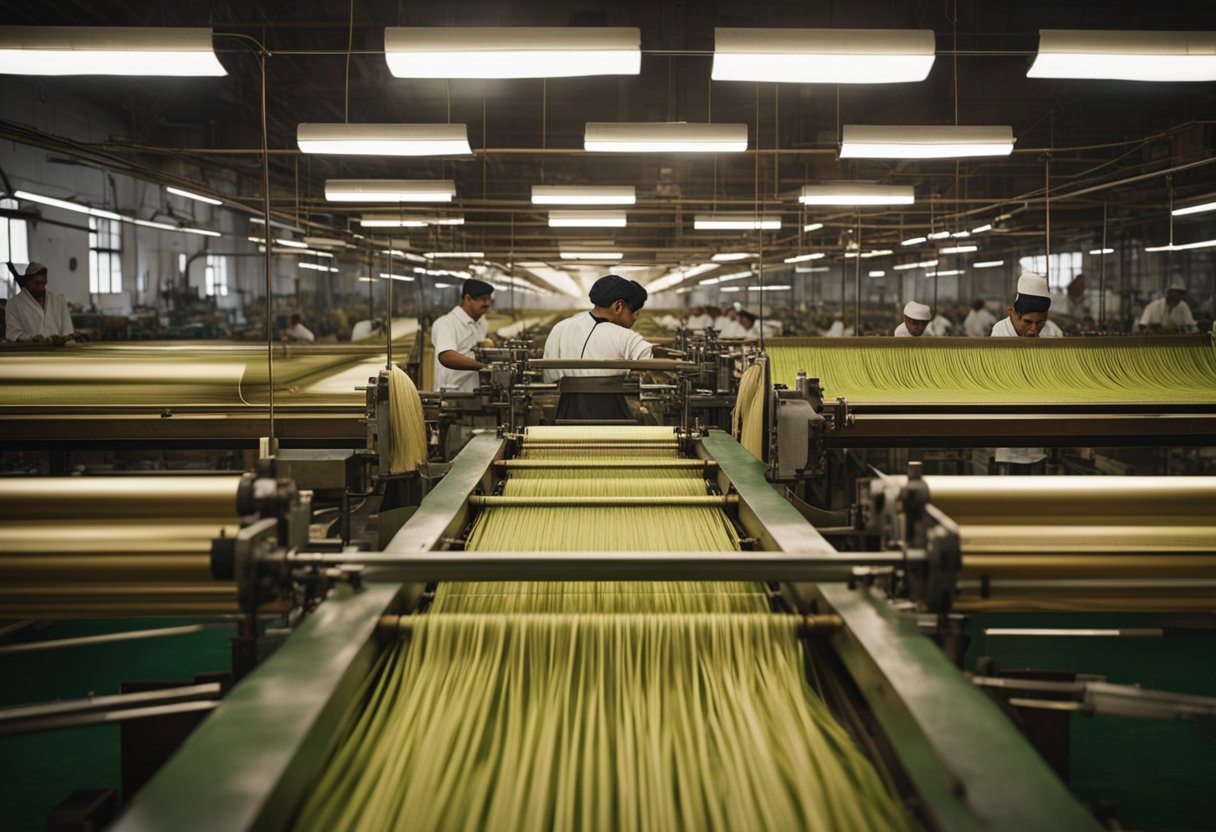
In the landscape of Italian luxury, silk factories stand as bastions of tradition and unrivalled craftsmanship. These establishments weave more than just fabric; they spin the tales of fashion and opulence.
Ratti and the Art of Printing
Ratti S.p.A has long been a cornerstone of the Italian silk industry. Based in Como, a city synonymous with silk production, Ratti has mastered the intricate art of printing on silk, marrying modern design with classic technique. Their work represents a perfect fusion of creativity and technological advancement, evident in the rich and intricate patterns that grace catwalks and collections worldwide.
Stefano Ricci: A Legacy of Luxury
The name Stefano Ricci epitomises luxury in the sphere of Italian silk. As a high-end producer, Stefano Ricci has established a legacy that echoes throughout the Italian fashion industry. This Florentine brand is not just a name but a standard-bearer for unparalleled quality and elegance, creating pieces that are both investment and heirloom, showcasing the full potential of Italian silk.
The Rich Tales of Milan’s Silk Giants
Often heralded as the capital of fashion, Milan is also home to renowned silk giants. Here, state-of-the-art factories blend time-honoured traditions with innovation to sustain Italy’s leadership in the silk sector. These Milanese titans are celebrated for supplying luxury brands with exquisite silk fabrics, which are then transformed into garments and accessories coveted globally.
Traditional Weaving and Dyeing Techniques
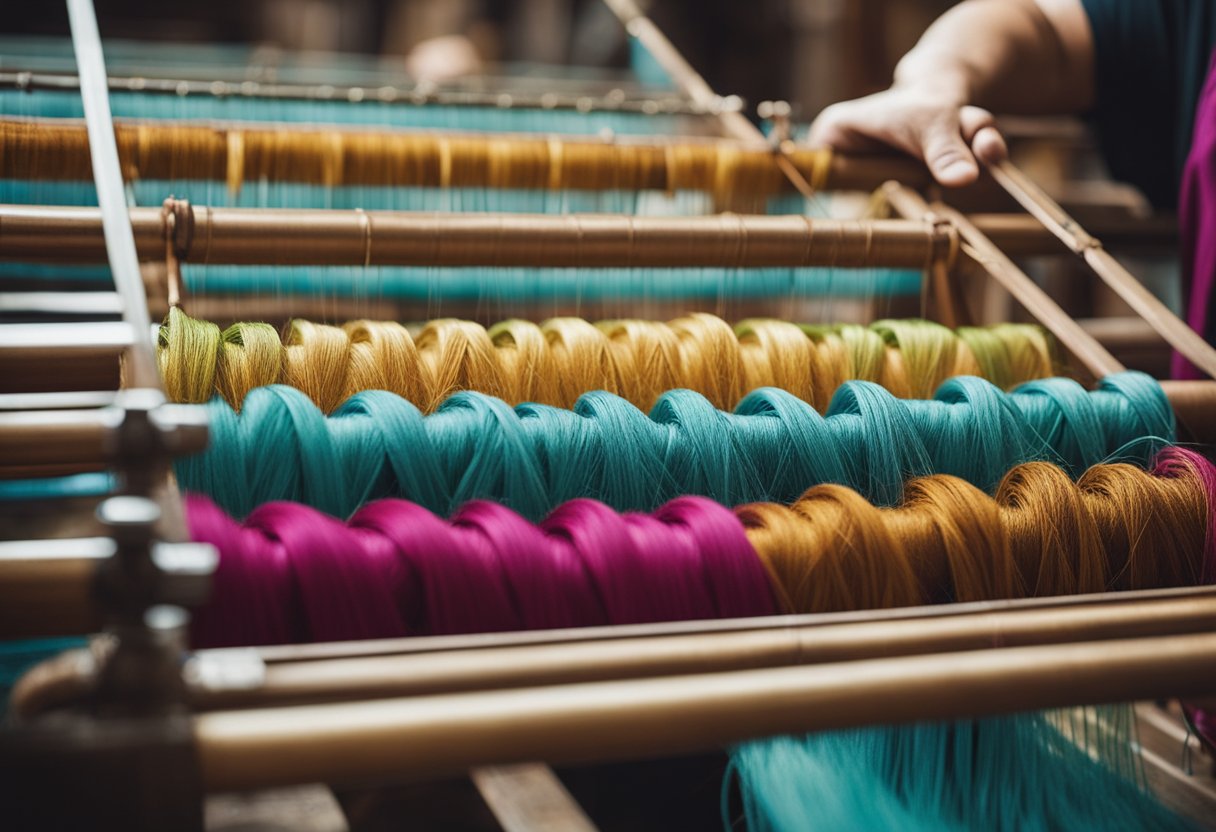
As we explore Italy’s treasured silk factories, we must recognise the significance of their time-honoured weaving and dyeing techniques. These methods are essential to creating Italy’s luxurious silk textiles and maintaining the country’s heritage in the industry.
The Jacquard Loom and Its Evolution
The introduction of the Jacquard loom was pivotal in advancing the silk-weaving industry. This loom, capable of producing intricate patterns, revolutionised the manufacturing of textiles. The process involves using punched cards meticulously created to control the loom’s pattern-making capabilities. The evolution of this technology, harmonising with modern technology, has ensured that traditional designs remain feasible even in contemporary applications, allowing complex patterning to be achieved with precision.
The Art of Dyeing and Finishing
When it comes to dyeing, the silk is handled with utmost care, typically dyed only in Italy to ensure the highest quality. The artful process transforms the white silk fibres into vivid hues that exhibit excellent colourfastness. The finishing processes further enhance the fabric, giving it the trademark sheen and softness that Italian silk is known for. These processes are critical, as they contribute to the richness and depth of the textile, ultimately defining the luxury of the finished product.
Preserving Craftsmanship in Modern Times
Preserving craftsmanship in silk factories acknowledges the balance between safeguarding tradition and embracing innovation. Skilled artisans employ traditional methods, such as hand-operating looms, which imbue each piece of silk with a unique character that machines cannot replicate. Our commitment to these methods ensures that the legacy of Italian silk-making continues to thrive, enriched by the selective integration of modern advancements that complement the original techniques without compromising the integrity of the craft.
Luxury Fashion, Accessories, and Trends
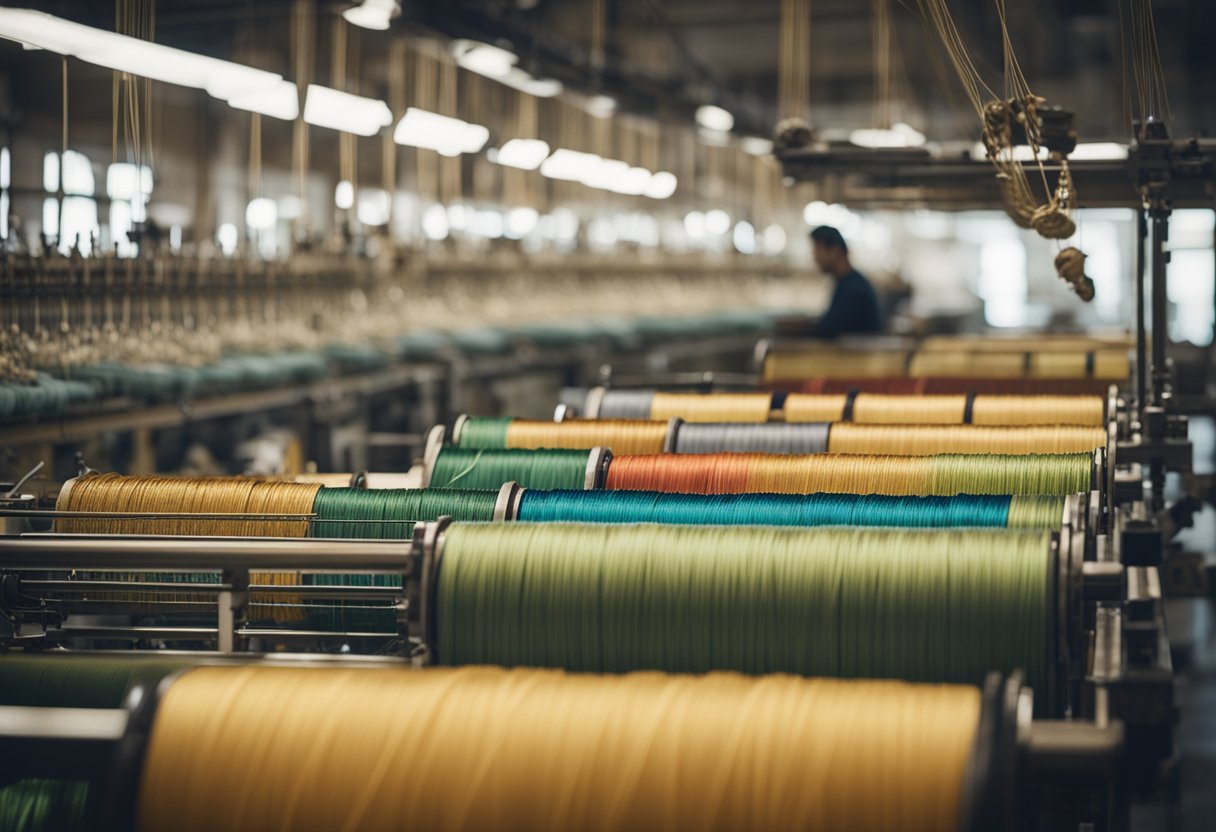
In Italy’s luxurious textile industry, fashion, ties, scarves, and diverse patterns emerge as embodiments of sophistication and trendsetting designs.
Silk Ties and Scarves
Italy’s reputation for premium silk is exemplified by the elegant silk ties and scarves that grace the collections of globally renowned fashion houses such as Gucci, Prada, and Versace. These accessories are not merely functional; they are status symbols that reflect the wearer’s taste and the rich heritage of Italian craftsmanship. From classic paisley designs to contemporary geometric patterns, Italian silk ties and scarves continue to set trends in the fashion world.
High Fashion and the Runway
The influence of Italy’s silk factories stretches to the high-end fashion runways, where luxury, innovation, and tradition converge. Fashion moguls from Italy showcase their latest collections each season, flaunting opulent fabrics and cutting-edge styles that often set the tone for global fashion trends. Whether an extravagant Gucci gown or a sleek Prada suit, the materials and craftsmanship speak of a long-standing tradition of elegance and luxury.
Patterns and Prints in Modern Wardrobe
Vibrant patterns and prints have become a staple in modern wardrobes, with Italian silk providing a canvas for endless creativity. The flawless transposition of intricate designs onto silk is a trademark of Italy’s artisanal expertise. These patterns and prints are donned by fashion aficionados across the globe and reflect Italy’s ability to merge traditional techniques with contemporary fashion sensibilities. They’re not just part of the wardrobe; they’re a statement, an expression of cultural richness that is continuously evolving.
The Global Influence of Italian Silk
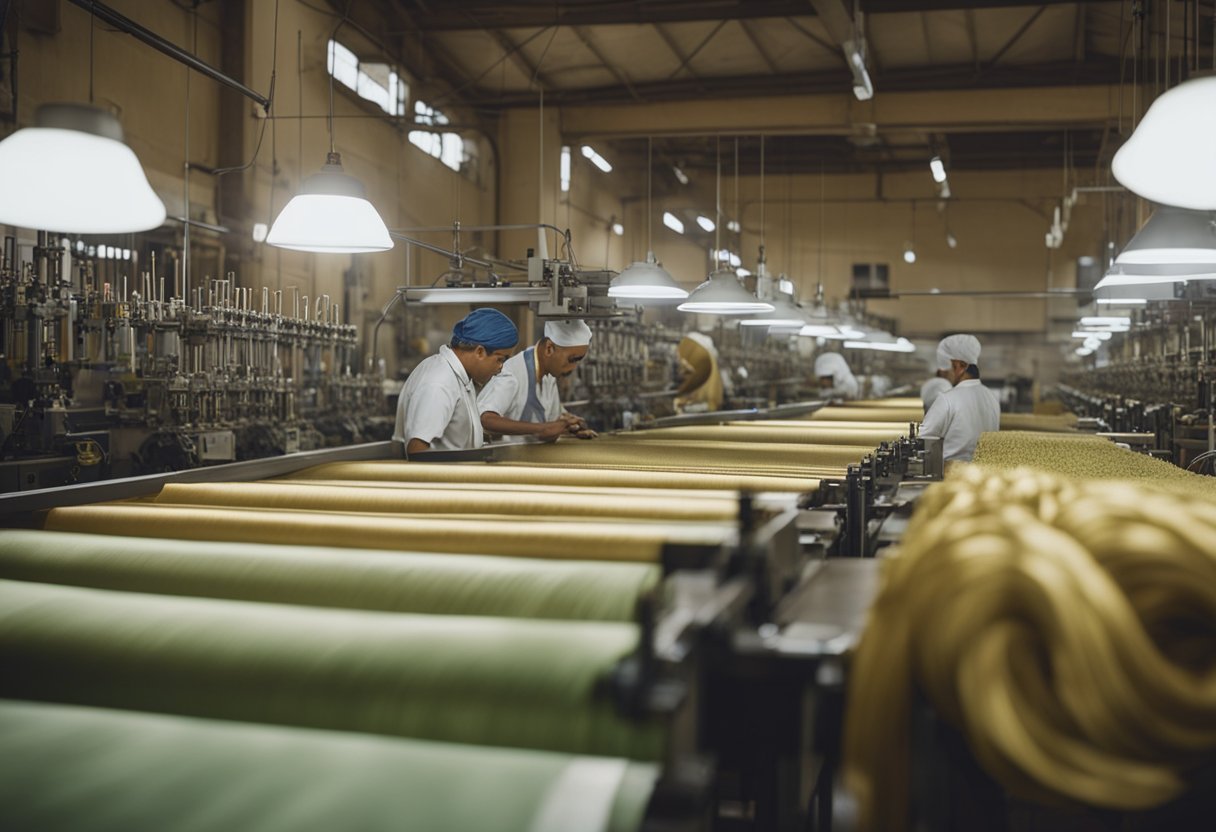
Italian silk has long been highly regarded for its quality and craftsmanship, casting a wide net of influence across global industries and cultures, particularly within fashion and luxury textiles.
China and Japan: The Eastern Connection
Italy’s silk legacy owes much to its Eastern connections, particularly with China and Japan, countries with their deep-seated heritage in silk production. Our trade with these nations has led to sharing techniques and aesthetics that have enriched the silk industry. The cross-pollination of ideas goes back centuries, stemming from the time of the Silk Road, where Italian traders would import precious silk to create fabrics revered across Europe. Today, this exchange has evolved into a sophisticated synergy between Italian design and Eastern silk production, ensuring the vitality of the global silk market.
Italian Silk in the Global Fashion Industry
The global fashion industry remains one of the primary stages where Italian silk shines, contributing significantly to our sartorial landscape. Italian silk manufacturers provide lavish materials synonymous with high fashion, sought after by prestigious fashion houses and discerning customers. The delicate weaves and rich textures developed in our factories serve Italy and fashion capitals from Paris to New York, solidifying the status of Italian silk as a cornerstone of luxury apparel. This has allowed us to nurture mutual growth and innovation within the international fashion sector, further solidifying our position as leaders in the silk industry.
Socio-Economic Impact and Silk Communities

The silk factories in Italy represent a fusion of deep-rooted craftsmanship and economic vigour, influencing the lives of those directly involved in the sericulture and the broader fabric of Italian cultural identity.
The Workers and Artisans
Italians working in silk factories are not just employees but guardians of an art form, weaving threads into luxurious textiles. These artisans, with their intricate skills, directly impact their communities by providing stable employment and sustaining local economies. For instance, the survival of a tiny workshop producing silk for prestigious clients reverberates through their town, underscoring silk’s role in community vitality.
Silk and Italy’s ‘Made in Italy’ Branding
‘Made in Italy’ is a cachet denoting quality and elegance, with silk starring. Silk items bear the hallmark of Italy’s high-fashion reputation, creating a ripple effect on the national economy and enhancing brand perception globally. The phrase rings as an endorsement of authenticity and Italian artisanship, pivotal for artisans working within the silk industry.
Educational and Cultural Contributions
Our museums and cultural institutions often highlight the historical and ongoing contributions of the silk trade. Educational programs inspire a new generation to engage with this traditional craft, ensuring that knowledge and passion for silk-making are passed down. Communities centred around silk production thus become repositories of cultural and practical knowledge, bridging past, present, and future.
In weaving the story of Italy’s silk factories, we acknowledge the socioeconomic fabric they enrich and their enduring legacy to Italian culture.
Italian Silk in Decor and Interior Design
Italian silk has long been associated with luxury and sophistication, making it a premier choice for homeowners and designers who aim to bring both elegance and comfort into their spaces.
Upholstery and Bedding Elegance
We find that Italian silk adds a touch of opulence to upholstery and bedding, with its glossy sheen and sumptuous feel. Upholstered furniture covered in Italian silk can serve as a focal point in any room, offering both visual and tactile luxury. Those in the know often choose silk fabrics for upholstering statement pieces like armchairs or sofas, creating a rich, inviting atmosphere. As for bedding, silk’s natural temperature-regulating properties make it ideal for duvets and pillowcases, promoting a sleep experience that combines comfort with the quiet grandeur.
Damask, Brocade, and Interior Trends
The intricate patterns of damask and brocade fabrics are synonymous with the Italian textile tradition. Damask, with its reversible patterns, imbues interior spaces with a subtle, sophisticated pattern. Brocade, on the other hand, offers raised designs often featuring floral or geometric motifs for a more opulent and tactile experience. We’ve seen these materials grace the interiors of the most discerning clients, including projects as illustrious as the White House and within the private quarters of the Pope. These fabrics are not just textiles but are considered pieces of art, reflecting centuries of Italian craft in every thread. They continue to be at the forefront of interior design trends, favoured for their luxurious appearance and historical significance.
The Future of Silk: Innovation and Sustainability
As we look ahead, the silk industry in Italy is on the brink of transformation, driven by both innovation and sustainability practices that herald a new era for silk production.
Integrating Eco-Friendly Practices
In our bid for a more sustainable future, Italian silk factories are adopting eco-friendly practices that minimise environmental impact. This includes the use of natural dyes, recycling water in the production process, and reducing energy consumption. Amid growing concerns over sustainability, producers are exploring how silk can be considered a sustainable fibre, viewing every phase of production through the lens of environmental responsibility. Such initiatives aim not just to preserve the local ecology, but also to establish a legacy of mindful luxury.
Technological Advances in Production
The integration of modern technology in traditional silk fabrication is paving the way for revolutionary advancements. Italian artisans are now supported by sophisticated machinery that enhances precision and efficiency. We observe innovations such as RESILK, which sees the regeneration of silk from industry surplus, championing the cause of waste reduction. As we harness these technologies, they enable us to do more than sustain — they allow us to evolve the time-honoured tradition of silk-making into a practice fit for tomorrow’s world.
Frequently Asked Questions
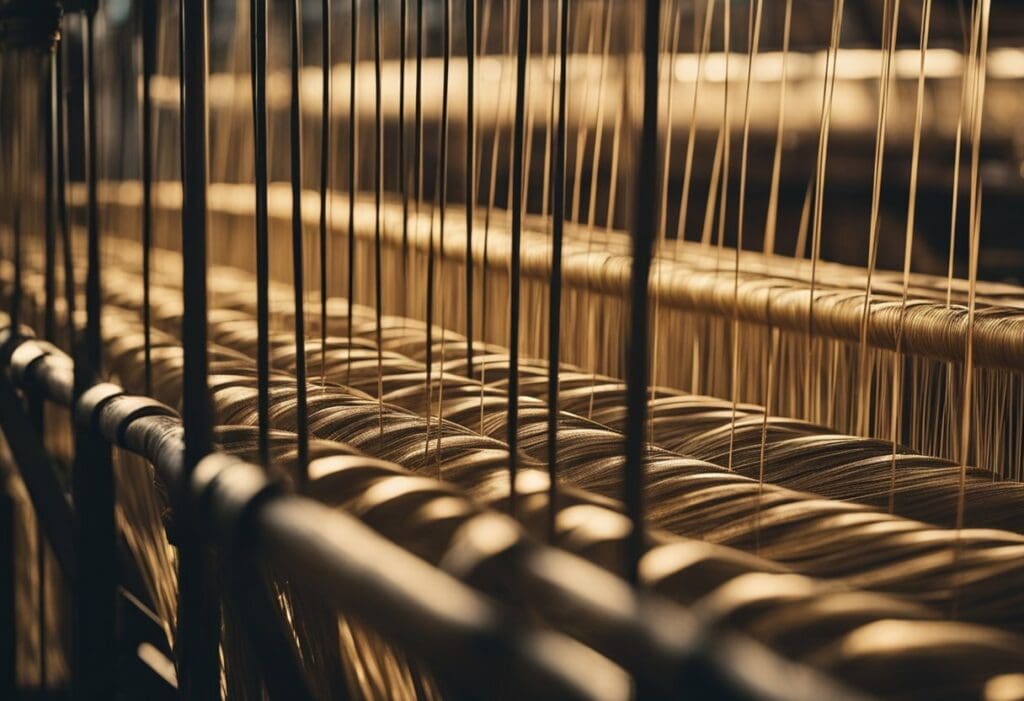
In our exploration of Italy’s historic silk industry, we often encounter a number of inquiries that reflect the enduring allure and mystique of Italian silk. The sections below aim to shed light on these commonly posed questions.
How has the tradition of silk production in Como evolved over the years?
Como has long been the epicentre of silk production in Italy, with a legacy that marries age-old techniques with modern innovations. Over time, Como’s silk manufacturers have adapted to new market demands without forgoing their commitment to quality and craftsmanship.
What distinguishes Italian silk from other silk in the global market?
Italian silk is renowned for its unparalleled quality, exquisite textures, and innovative designs. These silks are often seen as the gold standard due to their meticulous manufacture, which includes rigorous quality control and a keen eye for detail.
Where are the most reputable silk manufacturers located in Italy?
Besides Como, which is famous for its silk, there are noteworthy manufacturers spread across Italy. San Leucio, for example, is lauded for its historic silk-making traditions, and Florence is home to the Antico Setificio Fiorentino, a fabric mill known for its antique silk looms.
What role did silk play in Italy during the Renaissance?
During the Renaissance, Italian silk was a marker of wealth and social status. Its use in fashion and décor symbolised sophistication and affluence, and Italy was at the forefront of silk textile production and design during this time.
In what ways is silk considered a symbol of luxury in Italian craftsmanship?
Italian silk symbolises luxury due to its rich textures, lustrous finish, and the precision involved in its creation. Silk pieces are often custom-made and feature intricate designs that put forth Italy’s storied history in textile artistry.
How can one identify the authenticity of Italian silk products?
Authentic Italian silk products are characterised by their exceptional weave quality, unmatched softness, and authentic design patterns. Look for hallmarks of craftsmanship such as the hand finishing and the reputation of the manufacturer.






